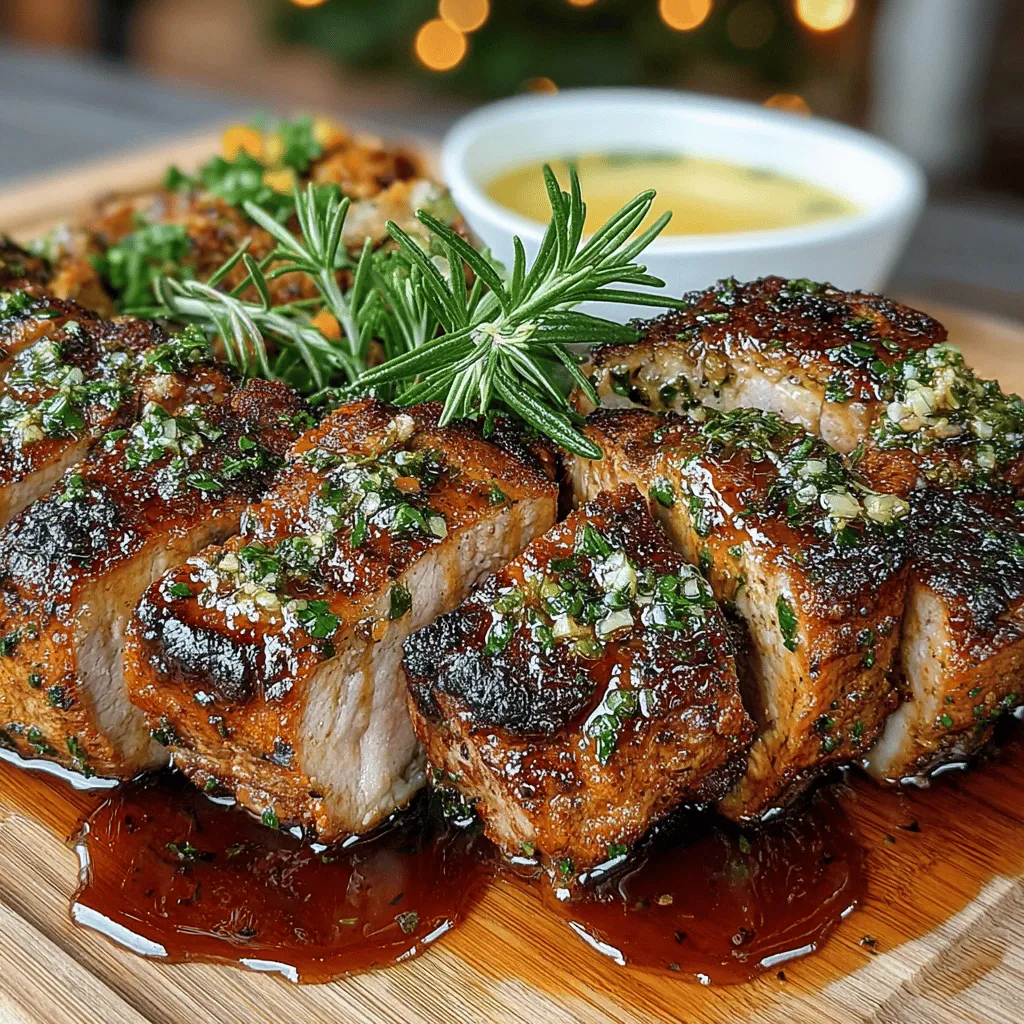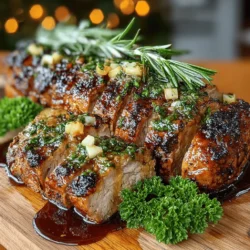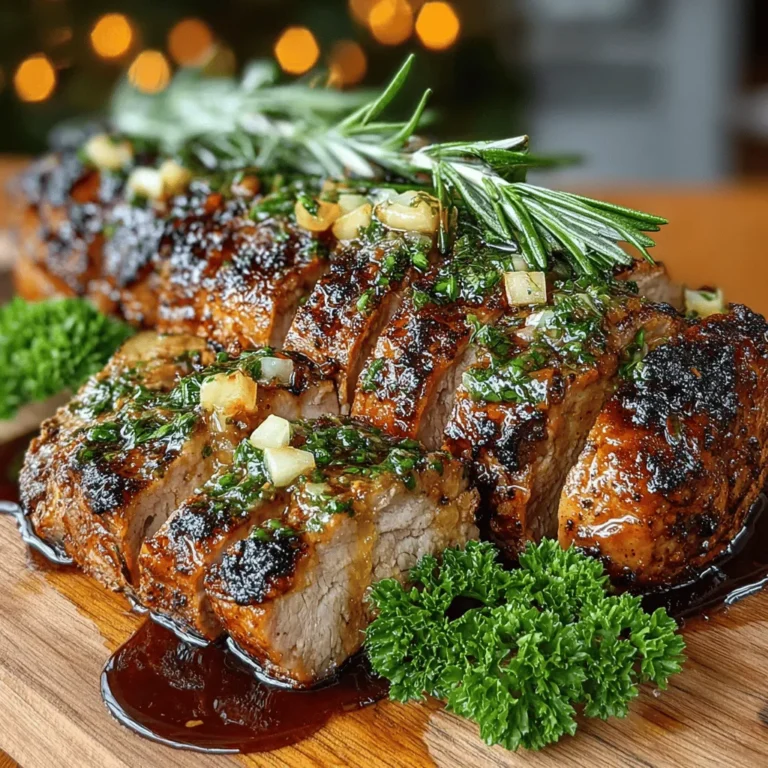Pork tenderloin has gained popularity as a go-to option for home cooks seeking a versatile and lean protein. Known for its tender texture and mild flavor, this cut of meat is an excellent canvas for a variety of seasonings and cooking methods. When prepared correctly, pork tenderloin can be the star of any meal, making it perfect for both weeknight dinners and special occasions. In this article, we will guide you through a delectable recipe for Savory Garlic Herb Roasted Pork Tenderloin, highlighting its simplicity, depth of flavor, and healthy preparation method.
One of the secrets to enhancing the taste of pork tenderloin lies in the use of marinades and herbs. Marinades not only infuse the meat with flavor but also help to tenderize it, resulting in a succulent dish. The combination of garlic, fresh herbs, and other flavorful ingredients creates a savory profile that elevates the pork to new heights. With this recipe, you will discover how easy it is to create a restaurant-quality meal right in your own kitchen.
All About Pork Tenderloin
Pork tenderloin is a long, thin cut of meat that runs along the backbone of the pig. It is prized for its delicate texture and mild flavor, making it a favorite among meat lovers. Unlike other cuts of pork, such as shoulder or belly, which can be fatty and require longer cooking times, pork tenderloin is lean and cooks relatively quickly.
One of the major nutritional benefits of pork tenderloin is its low-fat content combined with high protein levels. A typical serving of pork tenderloin provides a substantial amount of protein, making it a great choice for those looking to maintain a healthy diet. Additionally, it is rich in essential vitamins and minerals, including B vitamins, zinc, and iron, which are important for energy production and immune function.
When it comes to cooking pork tenderloin, various methods can be employed, including grilling, sautéing, or roasting. However, roasting is particularly favored for this recipe as it allows for even cooking while enhancing the natural flavors of the meat. Roasting also creates a beautiful caramelized crust on the outside, locking in moisture and ensuring a juicy interior.
Understanding the Ingredients
To create a truly flavorful Savory Garlic Herb Roasted Pork Tenderloin, it’s essential to understand the key ingredients that will contribute to the dish’s overall taste and texture.
Pork Tenderloin
When selecting pork tenderloin, look for a piece that is pinkish-red in color with minimal marbling. A well-trimmed tenderloin will have a slightly shiny surface and should feel firm to the touch. To prepare the pork, start by removing any silver skin, a tough connective tissue that can hinder the tenderness of the meat. Once prepared, the pork tenderloin is ready to absorb the delicious flavors of the marinade.
Garlic
Garlic is a culinary staple that adds a robust flavor to savory dishes, and its health benefits are well-documented. Rich in antioxidants and possessing anti-inflammatory properties, garlic can enhance the immune system while adding a wonderful aroma to the dish. For this recipe, fresh garlic cloves are used, which provide a more potent flavor than pre-minced varieties.
Fresh Herbs
The combination of fresh herbs, particularly rosemary, thyme, and parsley, plays a crucial role in creating a harmonious flavor profile for the pork tenderloin. Rosemary adds a pine-like essence that complements the meat, while thyme introduces earthy notes. Parsley serves as a fresh garnish, brightening the overall dish. Using fresh herbs instead of dried ones ensures a more vibrant taste.
Olive Oil
Extra virgin olive oil is a cornerstone of many Mediterranean recipes and is an ideal choice for this marinade. Not only does it help to bind the ingredients together, but it also contributes healthy fats that can enhance flavor. Olive oil is rich in monounsaturated fats, which are known to support heart health and reduce inflammation.
Lemon
Lemon juice adds a bright acidity to the marinade, balancing the richness of the pork. The acidity helps to tenderize the meat while enhancing the flavors of the other ingredients. A squeeze of lemon juice just before serving can further elevate the dish, providing a refreshing contrast to the savory elements.
Dijon Mustard
Dijon mustard is included in this recipe for its depth and tanginess. It adds a subtle heat and complexity to the flavor profile, making the marinade more interesting. Additionally, the mustard helps to create a slightly crusty exterior when roasted.
Chicken Broth
Using chicken broth in the roasting process enhances moisture and flavor, ensuring that the pork tenderloin remains juicy throughout cooking. The broth can also be used to deglaze the pan after roasting, creating a delicious sauce to drizzle over the meat before serving.
Preparation Steps for the Perfect Pork Tenderloin
With a clear understanding of the ingredients, you are well on your way to preparing a mouthwatering Savory Garlic Herb Roasted Pork Tenderloin. Follow these initial preparation steps to get started:
1. Marinate the Pork: Begin by preparing the marinade. In a mixing bowl, combine minced garlic, finely chopped fresh herbs, olive oil, lemon juice, Dijon mustard, salt, and pepper. Place the pork tenderloin in a resealable bag or a shallow dish and pour the marinade over it, ensuring that the meat is well coated. Allow it to marinate in the refrigerator for at least 30 minutes, or up to overnight for maximum flavor absorption.
2. Preheat the Oven: While the pork is marinating, preheat your oven to 425°F (220°C). This high temperature will help create a beautiful, caramelized crust on the tenderloin.
3. Sear the Pork: Once marinated, remove the pork tenderloin from the refrigerator. Heat a large oven-safe skillet over medium-high heat and add a drizzle of olive oil. Sear the pork on all sides until it is golden brown, about 3-4 minutes per side. This step is crucial for developing flavor and texture.
4. Prepare for Roasting: After searing, add chicken broth to the skillet, which will not only keep the pork moist but also create a flavorful base for a sauce. Transfer the skillet to the preheated oven and roast the pork tenderloin for approximately 20-25 minutes, or until the internal temperature reaches 145°F (63°C). Use a meat thermometer for accuracy, ensuring perfectly cooked pork.
In this first part of the article, we’ve laid the groundwork for creating a delicious Savory Garlic Herb Roasted Pork Tenderloin. With an understanding of the meat, its nutritional benefits, and the role of each ingredient, you’re ready to embark on a culinary journey that promises to deliver a flavor-packed delight. In the next section, we will delve into the finishing touches and serving suggestions that will elevate your dish to new heights.

When it comes to preparing a delicious and satisfying meal, marinating your proteins can make all the difference. In this section, we will explore the importance of marinating, detailed steps for preparing the marinade, and how to properly roast your pork tenderloin for the best results. We’ll also provide serving suggestions and discuss the health benefits of this dish.
The Importance of Marinating
Marinating is a crucial step in cooking that significantly enhances the flavor and tenderness of meats, including pork tenderloin. The process involves soaking the meat in a seasoned liquid, allowing it to absorb the flavors of the marinade while also breaking down tough muscle fibers. This results in a more flavorful and juicier dish. With our savory garlic herb marinade, expect a harmonious blend of garlic, herbs, and spices that will elevate your pork tenderloin to new heights.
Step-by-Step Breakdown of the Marinade Preparation
Ingredients for the Marinade
– 4 cloves of garlic, minced
– 2 tablespoons of fresh rosemary, chopped
– 2 tablespoons of fresh thyme, chopped
– 1 tablespoon of Dijon mustard
– ¼ cup of olive oil
– 2 tablespoons of balsamic vinegar
– Salt and pepper to taste
Mixing Techniques for the Garlic Herb Paste
1. Combine Ingredients: In a medium mixing bowl, combine the minced garlic, chopped rosemary, chopped thyme, Dijon mustard, olive oil, balsamic vinegar, salt, and pepper.
2. Whisk Together: Using a whisk, mix the ingredients until they are well blended. The olive oil should emulsify with the vinegar and herbs, creating a smooth paste.
3. Taste and Adjust: Before marinating the pork, taste the marinade and adjust seasoning if necessary. You may want to add more salt or herbs according to your preference.
Recommended Marination Time for Optimal Flavor Absorption
For the best flavor results, marinate the pork tenderloin for at least 2 hours, but ideally overnight. This extended marination allows the pork to absorb the garlic and herb flavors deeply, resulting in a more pronounced taste. If you’re short on time, even 30 minutes can provide a noticeable flavor boost, but overnight is best for maximum tenderness and flavor.
Searing and Deglazing: Techniques to Enhance Flavor
Searing the Meat
Once your pork has marinated, it’s time to sear it. Searing is essential for developing rich, complex flavors through the Maillard reaction, where sugars and amino acids in the meat brown and create a flavorful crust.
1. Preheat the Pan: Heat a large skillet over medium-high heat and add a tablespoon of olive oil.
2. Sear the Pork: Remove the pork from the marinade (discard any leftover marinade) and place it in the hot skillet. Sear for about 3-4 minutes on each side until a golden-brown crust forms.
The Importance of Deglazing
After searing, you’ll notice browned bits stuck to the bottom of the pan. This is where the flavor lives! Deglazing is the process of adding liquid (like broth or wine) to the hot pan to loosen these bits. Here’s how to do it:
1. Add Liquid: Once the pork is seared, pour in about ½ cup of chicken broth or white wine while scraping the bottom of the pan with a wooden spoon.
2. Create a Sauce: Bring the liquid to a simmer, allowing it to reduce slightly. This will become a delicious base for a sauce that you can drizzle over the pork once it’s roasted.
Roasting Techniques and Tips
Optimal Oven Temperature
For roasting pork tenderloin, an oven temperature of 400°F (200°C) is recommended. This temperature strikes a balance between cooking the pork thoroughly while also ensuring a nice caramelization on the outside without overcooking the inside.
How to Check for Doneness
The key to perfectly cooked pork tenderloin is monitoring the internal temperature. Use a meat thermometer to check the thickest part of the tenderloin; it should reach 145°F (63°C). This temperature ensures the pork is juicy and safe to eat.
Rest Time After Cooking
Once the pork is cooked, it’s essential to let it rest for about 5-10 minutes before slicing. This resting period allows the juices to redistribute throughout the meat, resulting in a tender and succulent bite. Cutting into the pork too early can cause the juices to run out, leaving you with a dry piece of meat.
Serving Suggestions
Presentation Ideas
When it comes to presenting your savory garlic herb roasted pork tenderloin, consider slicing the pork into medallions and arranging them on a platter. Drizzle with the deglazed sauce for added flavor and a glossy finish. Garnish with fresh herbs, such as rosemary or thyme sprigs, to enhance the visual appeal.
Pairing Recommendations
This pork tenderloin pairs beautifully with a variety of side dishes. Here are some recommendations:
– Roasted Vegetables: Seasonal vegetables like carrots, Brussels sprouts, and potatoes roasted in olive oil and herbs complement the pork nicely.
– Garlic Mashed Potatoes: Creamy mashed potatoes infused with garlic provide a comforting contrast to the savory pork.
– Crispy Green Salad: A refreshing salad with mixed greens, cherry tomatoes, and a light vinaigrette balances the richness of the pork.
Suggested Garnishes and Sauces
To add even more flavor to your dish, consider these garnishes and sauces:
– Herb Sauce: A simple sauce made with fresh herbs, olive oil, and lemon juice can brighten the dish.
– Apple Chutney: The sweetness of apple chutney pairs wonderfully with the savory pork, adding a touch of sweetness.
– Cranberry Sauce: A tart cranberry sauce can provide a lovely contrast to the rich flavors of the pork.
Health Considerations
Health Benefits of the Ingredients
Not only is this dish delicious, but it also offers several health benefits. Pork tenderloin is a lean cut of meat, making it lower in fat compared to other cuts. Additionally, the herbs used in the marinade, such as rosemary and thyme, are packed with antioxidants and may have anti-inflammatory properties.
Portion Sizes and Nutritional Balance
When serving this dish, consider portion control. A serving size of pork tenderloin is about 3-4 ounces, which provides sufficient protein while allowing space for healthy side dishes. Pairing the pork with vegetables ensures a balanced meal rich in vitamins and minerals.
Conclusion
In summary, the savory garlic herb roasted pork tenderloin is a dish that combines ease of preparation with exceptional flavor and health benefits. The marinating process enhances the meat’s tenderness and infuses it with delicious garlic and herb notes. Coupled with thoughtful cooking techniques like searing and roasting, this dish makes for a perfect centerpiece for family meals or gatherings.
We hope this recipe inspires you to explore the world of savory flavors and elevate your cooking. Give this garlic herb roasted pork tenderloin a try, and enjoy the compliments from your family and friends!

